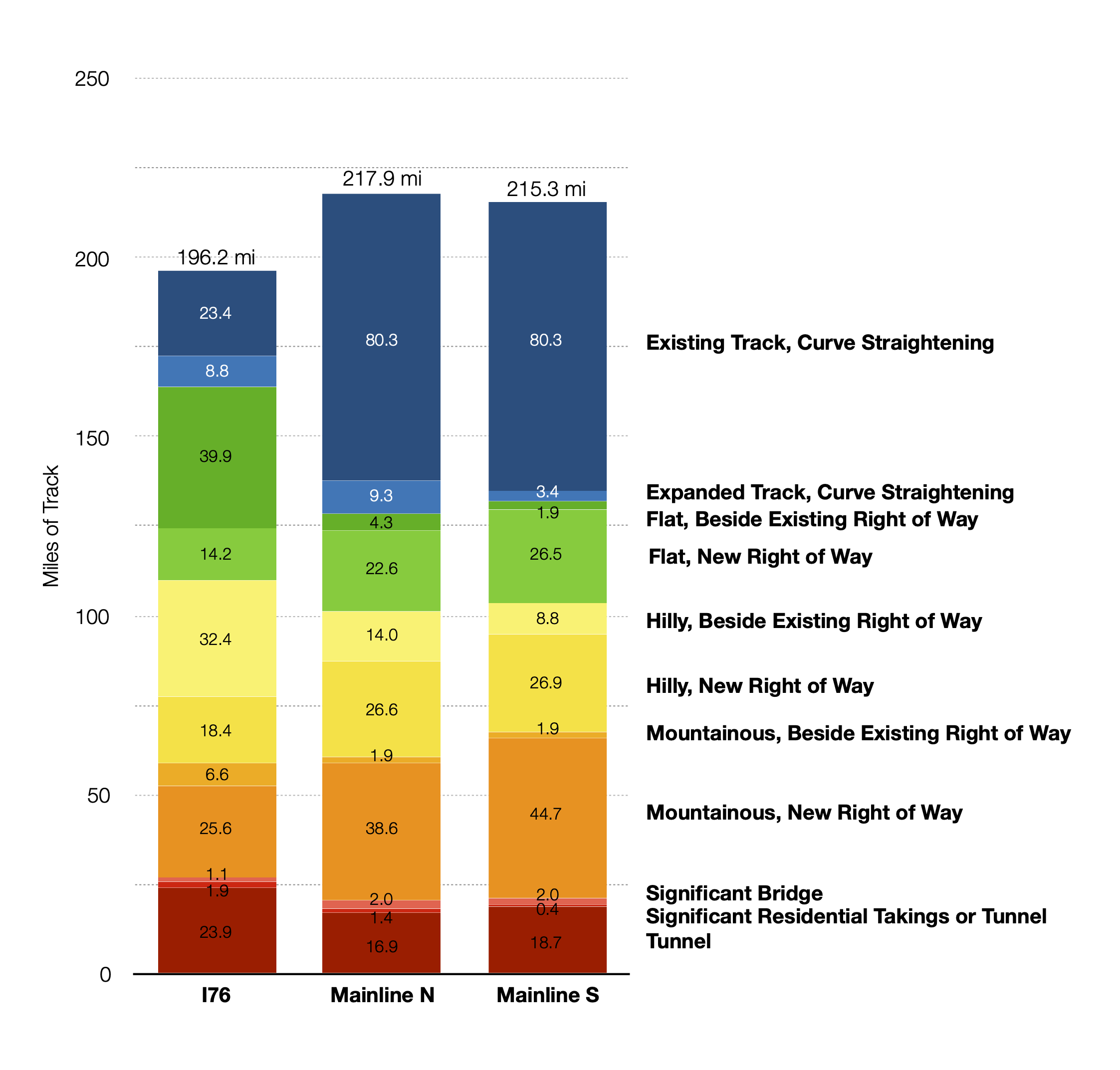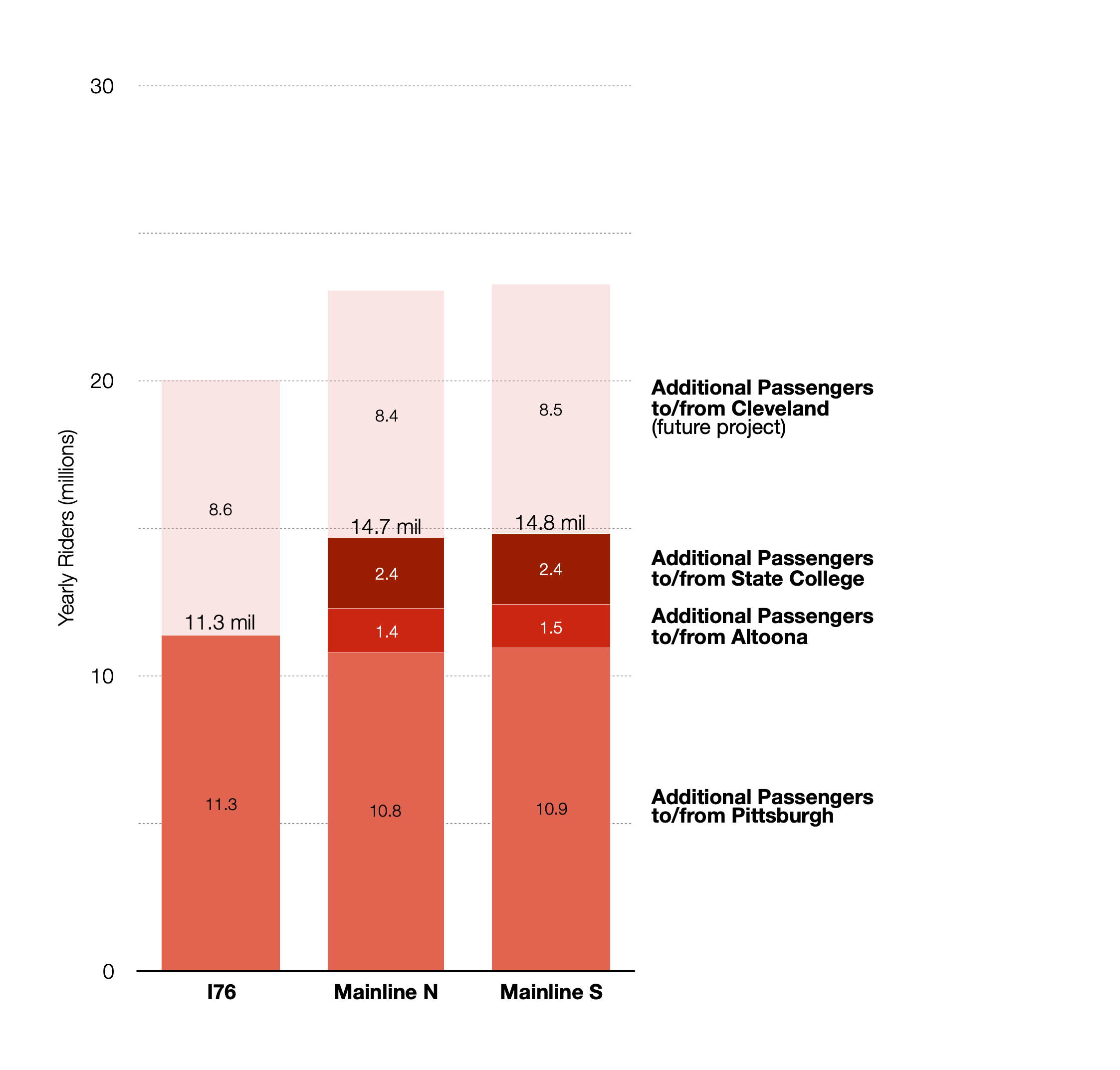individual independent project | 2020
As the Northeast Corridor evolves into true high speed rail, speeding its branches becomes a more and more beneficial next step. A high speed rail line through Pennsylvania will create the significant passenger rail link between the east coast and the midwest. This project analyzes the paths a high speed rail line could take through the Alleghenies, between Harrisburg and Pittsburgh, after track between Philadelphia and Harrisburg is upgraded. It is based on a more general cost-benefit analysis of potential high speed rail corridors in the United States by Alon Levy on his Pedestrian Observations blog.
Three alignments were studied:
Interstate 76
This alignment is perennially discussed as a greenfield line through southern Pennsylvania generally paralleling the Pennsylvania Turnpike. It connects Harrisburg to Pittsburgh with an intermediate station near Bedford mostly as an access point for State College and Altoona residents.
Mainline North
This alignment would generally follow the Pennsylvania Railroad Mainline but would have significant deviations to achieve higher speeds. One of the deviations would serve Penn State University in State College, PA. This line would also serve Altoona and various smaller towns between Altoona and Pittsburg. The northern mainline alternative serves State College with an urban station at the edge of the built-up university and downtown areas on a potential right-of-way comprising mostly Penn State University land.
Mainline South
This alignment is the same as the northern alignment, except that it would serve State College with a suburban station to the south of town and therefore would have different approaches through the surrounding mountains.

Both mainline routes are slightly longer than the I76 route, but both can include more upgraded legacy track on existing rights-of-way. Additionally, the mainline routes need less tunneling and a lower number of tunnels because the mountains they cross are often grouped together.

The length of the mainline routes impact ridership slightly from Pittsburgh and destinations west, but this is more than offset by ridership from midway stations in State College and Altoona.
Population of the two cities was determined based loosely on metropolitan statistical area populations, then around 50,000 students were added to the State College total. Still, this model probably undercounts State College ridership for multiple reasons:
- Most students are guaranteed to travel home six to eight times per year at the start and end of school breaks, and Penn State students’ homes are disproportionately near Philadelphia, Pittsburg, and, to a lesser extent, New York
- Students and Penn State faculty are generally especially wealthy and mobile
- Most students don’t bring a car to school or only bring their car to be able to get back to Philadelphia or Pittsburg during breaks—driving which could be replaced with rail trips
- State College is especially dense and walkable making access to the station by car, bus, bike, or foot quite efficient, especially important with a northern alignment and central, urban station
A stop near Bedford on the I76 line and smaller stations which may remain on the mainline were not included in this analysis because of their marginally impact. Specifically, ridership from State College or Altoona using the Bedford stop would be depressed by significantly longer travel times and operating profit would be dampened by the cost of running connecting services between the station and the two cities.
| Interstate 76 | Mainline North | Mainline South | |
| Capital Cost | $13.2 bil | $12.7 bil | $13.2 bil |
| Yearly Passengers | 11.3 mil | 14.7 mil | 14.8 mil |
| Yearly Operating Profit | $386 mil | $475 mil | $477 mil |
| Return on Investment | 2.9% | 3.7% | 3.6% |
Passenger counts and profits are based on a rough model created by Alon Levy. Capital costs are extremely roughly interpolated from cost estimate data from Alon Levy. All analysis is based on cost, fare, and ridership references in Central Europe. Differences between alignments rather than category amounts are by far the most sound vehicles for analysis.
The northern mainline alignment is the best alignment according to this analysis on almost every measure. It offers significantly higher passenger counts and profits than the Interstate 76 alignment at lower costs than either alternative. Additionally, following an existing rail mainline allows for the project to be completed in segments which can see immediate service. The ridership model did not account for proximity of the station to a city’s core, though with this consideration it is likely the urban station on the northern alignment would have higher ridership from State College than the southern mainline alignment and suburban station.
The northern mainline alignment also has the greatest potential for economic development, a measure not included elsewhere in the analysis. Both mainline alignments include more stations with significantly higher ridership potential, and an urban rather than suburban station in State College would further compound economic benefits. Economic development could include significant campus and downtown expansion to the east, detailed in the Downtown East Redevelopment plan. The line could also be used by Penn State as a connection between University Park Main Campus in State College, Penn State Milton S. Hershey Medical Center near Harrisburg, Penn State Harrisburg, Penn State Altoona, and campuses near Pittsburgh and Philadelphia.